Leeds
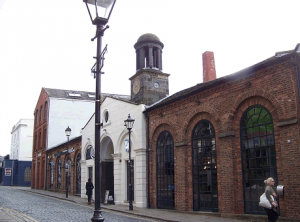
- Cloth hall in Leeds
- The entrance to the 1776 cloth hall in Leeds (the only remaining part - the galleries forming a courtyard behind are no longer in existence).
[click on the picture to enlarge it]
The Leeds area had from the Middle Ages been active in the production and trade of wool and cloth. Cloth halls were built in Leeds in the 18th century to house the cloth market, of which the 1776 cloth hall was the largest.
A remaining textile mill is Armley Mills, one and a half mile upstream from Leeds on the River Aire (West of Leeds), placed where the current is strong because of a small fall and a curve in the river course. It was first a ’fulling mill’ (finishing the cloth in water with fuller’s earth), fulling being the first process to be mechanised - pounding the cloth with hammers activated by waterwheels. Carding machines and looms were later introduced. There had been mills on the site since the 16th century; the present building, in fireproof materials (brick and iron), was built in 1805 after a fire.
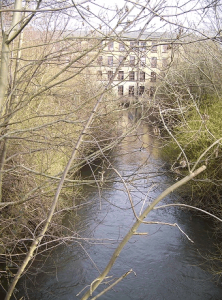
- Armley Mills
- The mill viewed from upstream (from the West), with the millpond, showing the features of industrial architecture: several storeys all with uniform tall windows.
[click on the picture to enlarge it]
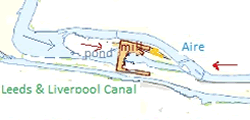
- Leeds & Liverpool Canal
- Armley Mills, with the viewing points of the photos (red arrows)
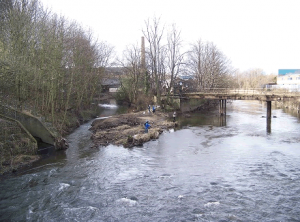
- Armley Mills
- Armley Mills viewed from downstream (East), showing the strong current.
It is now Leeds Industrial Museum, which has produced a simulation game, which « uses the life of cloth manufacturer Benjamin Gott (1762-1841) as a model for entrepreneurial skill and understanding. ».
[click on the picture to enlarge it]
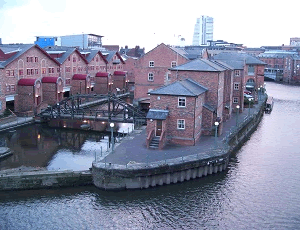
- the Aire at Leeds
- [click on the picture to enlarge it]
The need for textile machinery led to the foundation of engineering works such as that of Matthew Murray (1795), who became (1802) the Leeds rival of Boulton’s Birmingham engines. Murray’s engines replaced the long beam by up-and-down straight-line motion; being thus much smaller, they were built in his works and easily transported to be delivered ready to use in the clients’ factories, instead of having to be built on site in the clients’ factories like the large Boulton engine.
A newspaper, the Leeds Mercury, was founded in 1718.
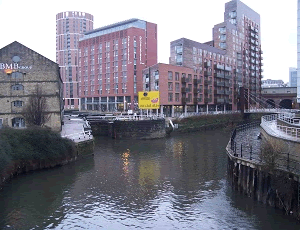
- the Aire at Leeds
- Present-day views: the Aire at Leeds, surrounded by warehouses; the junction of the Aire (right) and the Leeds and Liverpool canal with its first lock (left).
[click on the picture to enlarge it]
The development of Leeds was closely dependent on the improvement of waterways:
- the Aire, which flows eastwards to the Humber (Hull) and the North Sea, was navigable as far as Leeds from the late 17th century ;
- the Leeds and Liverpool Canal later connected Leeds westwards to Liverpool, conveying cotton for export; it flows into the Aire at Leeds, connecting the two seas.
The exports covered the British Empire and China as well as Europe.

